Canon previously announced its next AR/VR headset MREAL S1 back in October. Now, the Japan-based company has shown off the enterprise-focused device in a new video.
Update (January 27th, 2021): Canon Japan released the first promo video for their upcoming AR/VR headset, which uses a passthrough camera for room-scale augmented reality interactions. The headset is set to release in late February 2021.
Since Canon seems to be pitching the device only within Japan, YouTuber ‘Tyriel Wood’ did the courtesy of running the video through Google Translate so we can get a handle on the particulars.
In the video, we learn the headset weighs an impressive 137g, and claims to be the smallest, thinnest and lightest of Canon’s offerings. With the headstrap attached, it can be flipped in the upward position and adjusted for fit. A mechanical IPD adjuster is also built into the headset’s lenses. As previously seen, the MREAL S1 can also be used like a pair of hand-held binoculars, replete with light-blocking guard around the sides.
Original Article (October 7th, 2020): Unlike the MREAL Display MD-20, which was unveiled earlier this year, you might describe MREAL S1 as technically a VR headset with passthrough AR, which is achieved by the inclusion of stereoscopic camera sensors on the front of the device and VR displays, providing a ‘mixed reality’ view to the user. The headset also includes two additional optical sensors for positional tracking.

Canon Japan hasn’t released specs, prices or availability yet, however the company says on its Japan-facing site “the smallest and lightest video see-through MR device in the history of MREAL.”
MREAL S1 requires a PC tether to function (ie. not a standalone headset), however the company says its been created to work with mobile workstations, and is both cheaper and more portable than its predecessors, the MD-20 and 2016-era MD-10. Of course, some degree of that portability is owed by the headset’s notable lack of any sort of light-blocking blinders, although that’s been a design choice the company has made with all of their MREAL headsets to date.

As you’d imagine with any enterprise-focused AR headset, the head-mount version of MREAL S1 is designed for work with industrial applications, which might require two hands such as CAD software. The handheld style however was created for easier use at exhibitions.
Both MD-20 and MD-10 include this level of convertibility, however MREAL S1 is substantially smaller in size, slimming down to about the size of a smartphone. Its handheld configuration is also much less ungainly, as Canon has done away with the giant handles seen in previous models.
Like its previous AR headsets, MREAL S1 is likely to be a Japan-only device for companies there looking to partner with the Canon.






